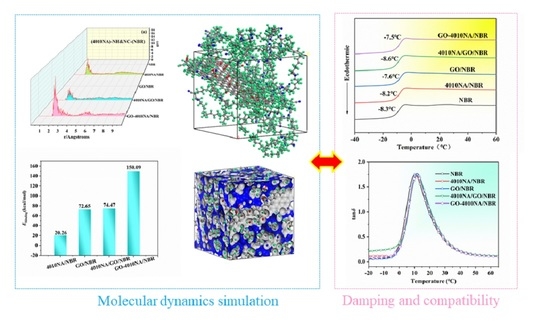Investigation of the Compatibility and Damping Performance of Graphene Oxide Grafted Antioxidant/Nitrile-Butadiene Rubber Composite: Insights from Experiment and Molecular Simulation
Abstract
:1. Introduction
2. Experimental Section
2.1. Materials
2.2. Preparation of NBR Composites
2.2.1. Synthesis of Anti-Migration Antioxidant GO-4010NA
2.2.2. Preparation of NBR Composites
2.3. Characterization
3. Model and Simulation Details
3.1. Construction of GO Model
3.2. Construction of Composite System Model
4. Results and Discussion
4.1. Structure Analysis of the Synthetic Antioxidant GO-4010NA
4.2. FTIR Analysis of NBR Composites
4.3. DSC Analysis NBR Composites
4.4. Dynamic Mechanical Properties of NBR Composites
4.5. Molecular Simulation Data Analysis
4.5.1. Compatibility Analysis of 4010NA, GO, GO-4010NA and NBR
4.5.2. Charge Analysis of Atoms on Polar Functional Groups
4.5.3. Accurate Statistics of Types and Number of H-Bonds
4.5.4. Binding Energy Analysis of NBR Composites
4.5.5. Free Volume Fraction (FFV) of Different NBR Composites
4.5.6. Migration of Antioxidant 4010NA and Anti-Migration GO-4010NA
5. Conclusions
- (1)
- DSC results show that NBR has good compatibility with 4010NA, GO, or GO-4010NA. Compared with 4010NA/NBR composite, the Tg of the GO-4010NA/NBR composite is increased, which is due to more H-bond networks formed between GO-4010NA and the NBR matrix. DMA results show that the addition of GO-4010NA can increase the damping performance of NBR more effectively than the addition of 4010NA.
- (2)
- Through MD simulation, the two-component solubility parameters between 4010NA, GO, GO-4010NA, and NBR matrix is calculated. Compared with 4010NA, the addition of GO-4010NA significantly improved the compatibility with NBR. The MD simulation is used to calculate the H-bonds, binding energy, and FFV of the NBR composites with different fillers. Compared with 4010NA/NBR composite, the GO-4010NA/NBR composite has more H-bonds, larger binding energy, and smaller FFV, indicating GO-4010NA/NBR composite has the better damping performance, which is consistent with the DMA results.
- (3)
- Grafting 4010NA onto GO not only inhibits the migration of 4010NA but also improves the damping property of the NBR matrix. GO-4010NA is expected to be a functional filler for the preparation of high-damping NBR composites.
Author Contributions
Funding
Institutional Review Board Statement
Informed Consent Statement
Data Availability Statement
Acknowledgments
Conflicts of Interest
References
- Xu, K.M.; Hu, Q.M.; Wu, H.; Guo, S.Y.; Zhang, F.S. Designing a polymer-based hybrid with simultaneously improved mechanical and damping properties via a multilayer structure construction: Structure evolution and a damping mechanism. Polymers 2020, 12, 446. [Google Scholar] [CrossRef] [PubMed] [Green Version]
- Wu, C.F.; Yamagishi, T.A.; Nakamoto, Y.; Ishida, S.I.; Nitta, K.H. Organic hybrid of chlorinated polyethylene and hindered phenol. I. Dynamic mechanical properties. J. Polym. Sci. Pol. Phys. 2000, 38, 2285–2295. [Google Scholar] [CrossRef]
- Zhang, J.H.; Wang, L.F.; Zhao, Y.F. Fabrication of novel hindered phenol/phenol resin/nitrile butadiene rubber hybrids and their long-period damping properties. Polym. Compos. 2012, 33, 2125–2133. [Google Scholar] [CrossRef]
- Xu, K.M.; Zhou, H.D.; Hu, Q.M.; Wang, J.H.; Huang, Y.; Chen, J.L. Molecular insights into chain length effects of hindered phenol on the molecular interactions and damping properties of polymer-based hybrid materials. Polym. Eng. Sci. 2020, 3, 446–454. [Google Scholar] [CrossRef]
- Zhao, X.Y.; Xiao, D.L.; Wu, S.Z.; Feng, Y.P.; Zhang, L.Q.; Wang, W.M. Oriented distribution structure, interaction, and performance of thermoplastic polyurethane/selective hindered amine hybrids. J. Appl. Polym. Sci. 2011, 120, 906–913. [Google Scholar] [CrossRef]
- Zhao, X.Y.; Xiang, P.; Tian, M.; Fong, H.; Jin, R.; Zhang, L.Q. Nitrile butadiene rubber/hindered phenol nanocomposites with improved strength and high damping performance. Polymer 2007, 20, 6056–6063. [Google Scholar] [CrossRef]
- Song, M.; Yue, X.L.; Wang, X.J.; Cao, F.Y.; Li, Y.N.; Su, C.H.; Qin, Q. Effect of hindered phenol AO-80 on the damping properties for nitrile-Butadiene rubber/phenolic resin: Molecular simulation and experimental study. Macromol. Mater. Eng. 2020, 305, 2000222. [Google Scholar] [CrossRef]
- Qiao, B.; Zhao, X.Y.; Yue, D.M.; Zhang, L.Q.; Wu, S.Z. A combined experiment and molecular dynamics simulation study of hydrogen bonds and free volume in nitrile-butadiene rubber/hindered phenol damping mixtures. J. Mater. Chem. 2012, 22, 12339–12348. [Google Scholar] [CrossRef]
- Zhu, J.; Zhao, X.Y.; Liu, L.; Yang, R.N.; Song, M.; Wu, S.Z. Thermodynamic analyses of the hydrogen bond dissociation reaction and their effects on damping and compatibility capacities of polar small molecule/nitrile-butadiene rubber systems: Molecular simulation and experimental study. Polymer 2018, 155, 152–167. [Google Scholar] [CrossRef]
- Song, M.; Yue, X.L.; Wang, X.J.; Huang, M.J.; Ma, M.X.; Pan, W.; Qin, Q. Improved high-temperature damping performance of nitrile-butadiene rubber/phenolic resin composites by introducing different hindered amine molecules. e-Polymers 2020, 20, 482–490. [Google Scholar] [CrossRef]
- Komethi, M.; Othman, N.; Ismail, H.; Sasidharan, S. Comparative study on natural antioxidant as an aging retardant for natural rubber vulcanizates. J. Appl. Polym. Sci. 2012, 124, 1490–1500. [Google Scholar] [CrossRef]
- Nawaz, S.; Hillborg, H.; Hedenqvist, M.S.; Gedde, U.W. Migration of a phenolic antioxidant from aluminium oxide-poly (ethylene-co-butyl acrylate) nanocomposites in aqueous media. Polym. Degrad. Stabil. 2013, 98, 475–480. [Google Scholar] [CrossRef]
- Graciano-Verdugo, A.Z.; Soto-Valdez, H.; Peralta, E.; Cruz-Zárate, P.; Islas-Rubio, A.R.; Sánchez-Valdes, S.; Sánchez-Escalante, A.; González-Méndez, N.; González-Ríosb, H. Migration of α-tocopherol from LDPE films to corn oil and its effect on the oxidative stability. Food Res. Int. 2010, 43, 1073–1078. [Google Scholar] [CrossRef]
- Wang, X.J.; Chen, X.H.; Song, M.; Wang, Q.F.; Zheng, W.; Song, H.J.; Fan, Z.H.; Thu, A.M. Effects of hindered phenol organic molecules on enhancing thermo-oxidative resistance and damping capacity for nitrile butadiene rubber: Insights from experiments and molecular simulation. Ind. Eng. Chem. Res. 2020, 59, 11494–11504. [Google Scholar] [CrossRef]
- Buchmüller, Y.; Wokaun, A.; Gubler, L. Polymer-bound antioxidants in grafted membranes for fuel cells. J. Mater. Chem. A 2014, 2, 5870–5882. [Google Scholar] [CrossRef]
- Wu, W.J.; Zeng, X.R.; Li, H.Q.; Lai, X.J.; Xie, H. Synthesis and antioxidative properties in natural rubber of novel macromolecular hindered phenol antioxidants containing thioether and urethane groups. Polym. Degrad. Stabil. 2015, 111, 232–238. [Google Scholar] [CrossRef]
- Kim, T.H.; Oh, D.R. Melt grafting of maleimides having hindered phenol antioxidant onto low molecular weight polyethylene. Polym. Degrad. Stabil. 2004, 84, 499–503. [Google Scholar] [CrossRef]
- Gao, X.W.; Meng, X.F.; Wang, H.T.; Wen, B.; Ding, Y.F.; Zhang, S.M.; Yang, M.S. Antioxidant behaviour of a nanosilica-immobilized antioxidant in polypropylene. Polym. Degrad. Stabil. 2008, 93, 1467–1471. [Google Scholar] [CrossRef]
- Zhou, J.J.; Wei, L.Y.; Wei, H.T.; Zheng, J.; Huang, G.S. The synthesis of graphene-based antioxidants to promote anti-thermal properties of styrene-butadiene rubber. RSC Adv. 2017, 7, 53596–53603. [Google Scholar] [CrossRef] [Green Version]
- Zhu, L.; Chen, X.; Shi, R.R.; Zhang, H.; Han, R.; Cheng, X.; Zhou, C.J. Tetraphenylphenyl-modified damping additives for silicone rubber: Experimental and molecular simulation investigation. Mater. Design 2021, 202, 109551. [Google Scholar] [CrossRef]
- Yang, H.L.; Cai, F.; Luo, Y.L.; Ye, X.; Zhang, C.; Wu, S.Z. The interphase and thermal conductivity of graphene oxide/butadiene-styrene-vinyl pyridine rubber composites: A combined molecular simulation and experimental study. Compos. Sci. Technol. 2020, 188, 107971. [Google Scholar] [CrossRef]
- Panahi, F.; Fareghi-Alamdari, R.; Khajeh Dangolani, S.; Khalafi-Nezhad, A.; Golestanzadeh, M. Graphene grafted N-methyl-4-pyridinamine(G-NMPA):an efficient heterogeneous organocatalyst for acetylation of alcohols. ChemistrySelect 2017, 2, 474–479. [Google Scholar] [CrossRef]
- Lin, Y.L.; Chen, Y.Z.; Zeng, Z.K.; Zhu, J.R.; Wei, Y.; Li, F.C.; Liu, L. Effect of ZnO nanoparticles doped graphene on static and dynamic mechanical properties of natural rubber composites. Compos. Part A Appl. Sci. Manuf. 2015, 70, 35–44. [Google Scholar] [CrossRef]
- Cao, R.; Chen, Z.; Wu, Y.H.; Tu, Y.F.; Wu, G.X.; Yang, X.M. Precisely controlled growth of poly(ethyl acrylate) chains on graphene oxide and the formation of layered structure with improved mechanical properties. Compos. Part A Appl. Sci. Manuf. 2017, 93, 100–106. [Google Scholar] [CrossRef]
- Mohamed, M.A.; Yehia, A.M.; Banks, C.E.; Allam, N.K. Novel MWCNTs/graphene oxide/pyrogallol composite with enhanced sensitivity for biosensing applications. Biosens. Bioelectron. 2017, 89, 1034–1041. [Google Scholar] [CrossRef]
- Smaoui, I.; Domatti, A.; Kharrat, M.; Dammak, M.; Monteil, G. Eco-friendly nanocomposites between carboxylated acrylonitrile–butadiene rubber (XNBR) and graphene oxide or graphene at low content with enhanced mechanical properties. Fuller. Nanotub. Carbon Nanostructures 2016, 24, 769–778. [Google Scholar] [CrossRef]
- Yu, B.; Shi, Y.Q.; Yuan, B.H.; Qiu, S.; Xing, W.Y.; Hu, W.Z.; Song, L.; Lo, S.M.; Hu, Y. Enhanced thermal and flame retardant properties of flame-retardant-wrapped graphene/epoxy resin nanocomposites. J. Mater. Chem. A 2015, 15, 8034–8044. [Google Scholar] [CrossRef]
- He, S.J.; Luo, C.M.; Zheng, Y.Z.; Xue, Y.; Song, X.P.; Lin, J. Improvement in the charge dissipation performance of epoxy resin composites by incorporating amino-modified boron nitride nanosheets. Mater. Lett. 2021, 298, 130009. [Google Scholar] [CrossRef]
- He, S.J.; Wang, J.Q.; Hu, J.B.; Zhou, H.F.; Nguyen, H.; Luo, C.; Lin, J. Silicone rubber composites incorporating graphitic carbon nitride and modified by vinyl tri-methoxysilane. Polym. Test. 2019, 79, 106005. [Google Scholar] [CrossRef]
- Zhong, R.; Zhang, Z.; Zhao, H.G.; He, X.R.; Wang, X.; Zhang, R. Improving thermo-oxidative stability of nitrile rubber composites by functional graphene oxide. Materials 2018, 11, 921. [Google Scholar] [CrossRef] [Green Version]
- Yao, J.L.; Liu, S.X.; Huang, Y.J.; Ren, S.J.; Lv, Y.D.; Kong, M.Q.; Li, G.X. Acyl-chloride functionalized graphene oxide chemically grafted with hindered phenol and its application in anti-degradation of polypropylene. Prog. Nat. Sci. 2020, 30, 328–336. [Google Scholar] [CrossRef]
- Zhong, B.C.; Dong, H.H.; Luo, Y.F.; Zhang, D.Q.; Jia, Z.X.; Jia, D.M.; Liu, F. Simultaneous reduction and functionalization of graphene oxide via antioxidant for highly aging resistant and thermal conductive elastomer composites. Compos. Sci. Technol. 2017, 151, 156–163. [Google Scholar] [CrossRef]
- Luo, Y.L.; Li, T.T.; Li, B.; Chen, X.L.; Luo, Z.Y.; Gao, Y.Y.; Zhang, L.Q. Effect of the nanoparticle functionalization on the cavitation and crazing process in the polymer nanocomposites. Chinese J. Polym. Sci. 2021, 39, 249–257. [Google Scholar] [CrossRef]
- Medhekar, N.V.; Ramasubramaniam, A.; Ruofr, R.S.; Shenoy, V.B. Hydrogen bond networks in graphene oxide composite paper: Structure and mechanical properties. ACS Nano 2010, 4, 2300–2306. [Google Scholar] [CrossRef] [PubMed]
- Lerf, A.; He, H.; Forster, M.; Klinowski, J. Structure of graphite oxide revisited. J. Phys. Chem. B 1998, 102, 4477–4482. [Google Scholar] [CrossRef]
- Cai, F.; You, G.H.; Luo, K.Q.; Zhang, H.; Zhao, X.Y.; Wu, S.Z. Click chemistry modified graphene oxide/styrene-butadiene rubber composites and molecular simulation study. Compos. Sci. Technol. 2020, 190, 108061. [Google Scholar] [CrossRef]
- Hansen, C.M. Hansen Solubility Parameters: A User’s Handbook; CRC Press: Boca Raton, FL, USA, 2007. [Google Scholar]
- Luo, K.Q.; You, G.H.; Zhao, X.Y.; Lu, L.; Wang, W.C.; Wu, S.Z. Synergistic effects of antioxidant and silica on enhancing thermo-oxidative resistance of natural rubber: Insights from experiments and molecular simulations. Mater. Design 2019, 181, 107944. [Google Scholar] [CrossRef]
- Wang, X.J.; Song, M.; Liu, S.T.; Wu, S.Z.; Thu, A.M. Analysis of phthalate plasticizer migration from PVDC packaging materials to food simulants using molecular dynamics simulations and artificial neural network. Food Chem. 2020, 317, 126465. [Google Scholar] [CrossRef]
- Luo, Y.L.; Wang, R.G.; Wang, W.; Zhang, L.Q.; Wu, S.Z. Molecular dynamics simulation insight into two-component solubility parameters of graphene and thermodynamic compatibility of graphene and styrene butadiene rubber. J. Phys. Chem. C 2017, 121, 10163–10173. [Google Scholar] [CrossRef]
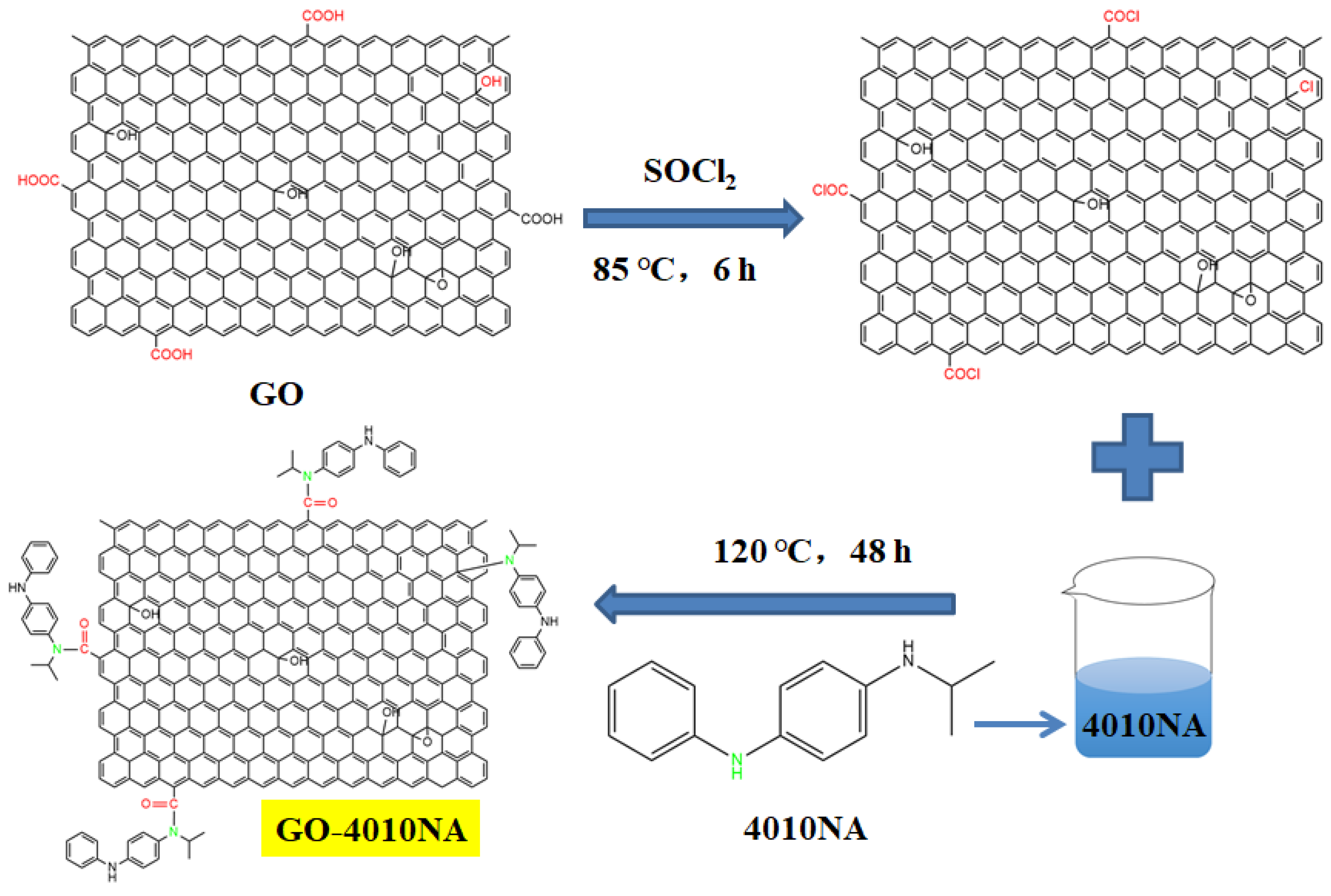

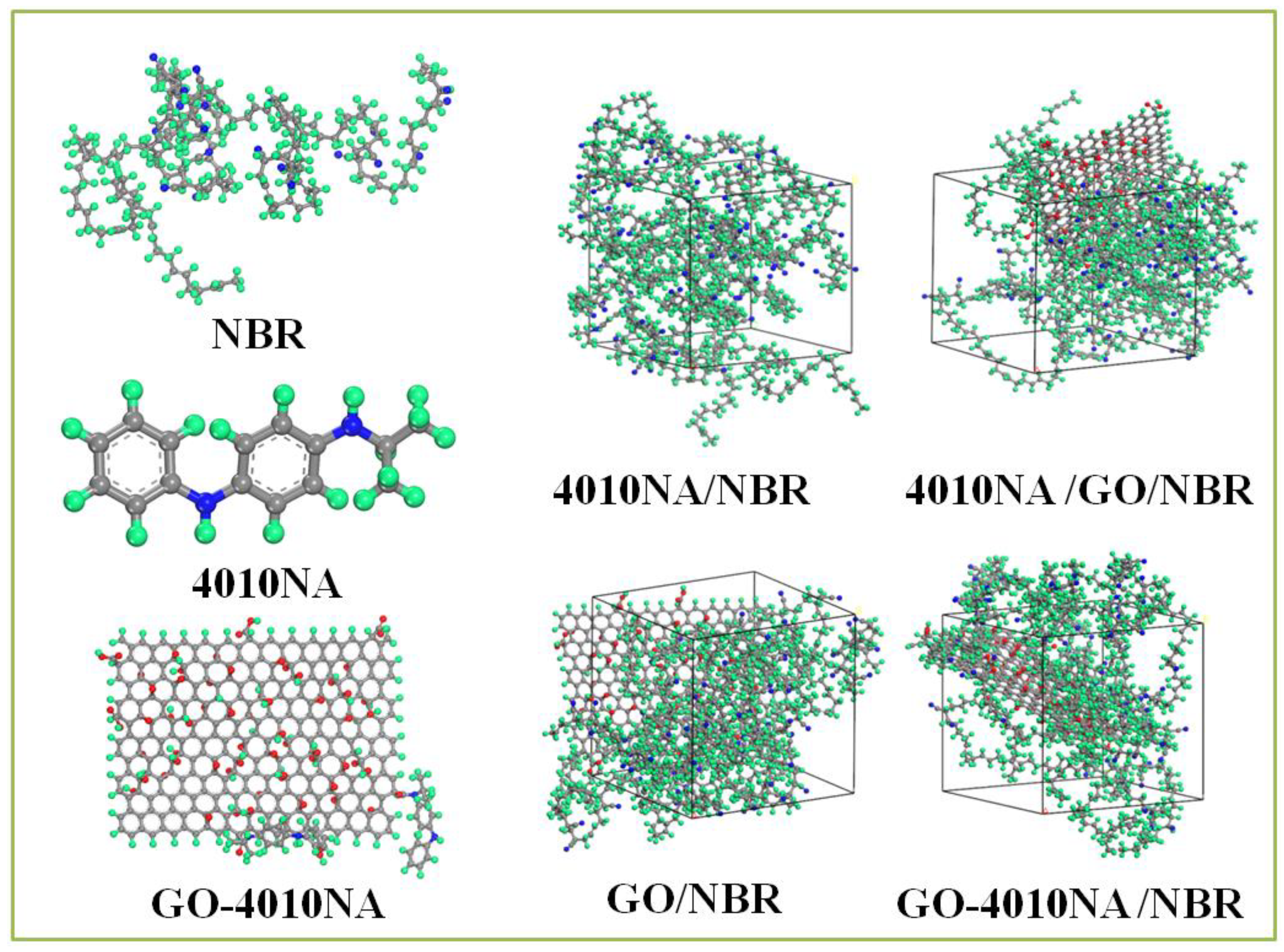
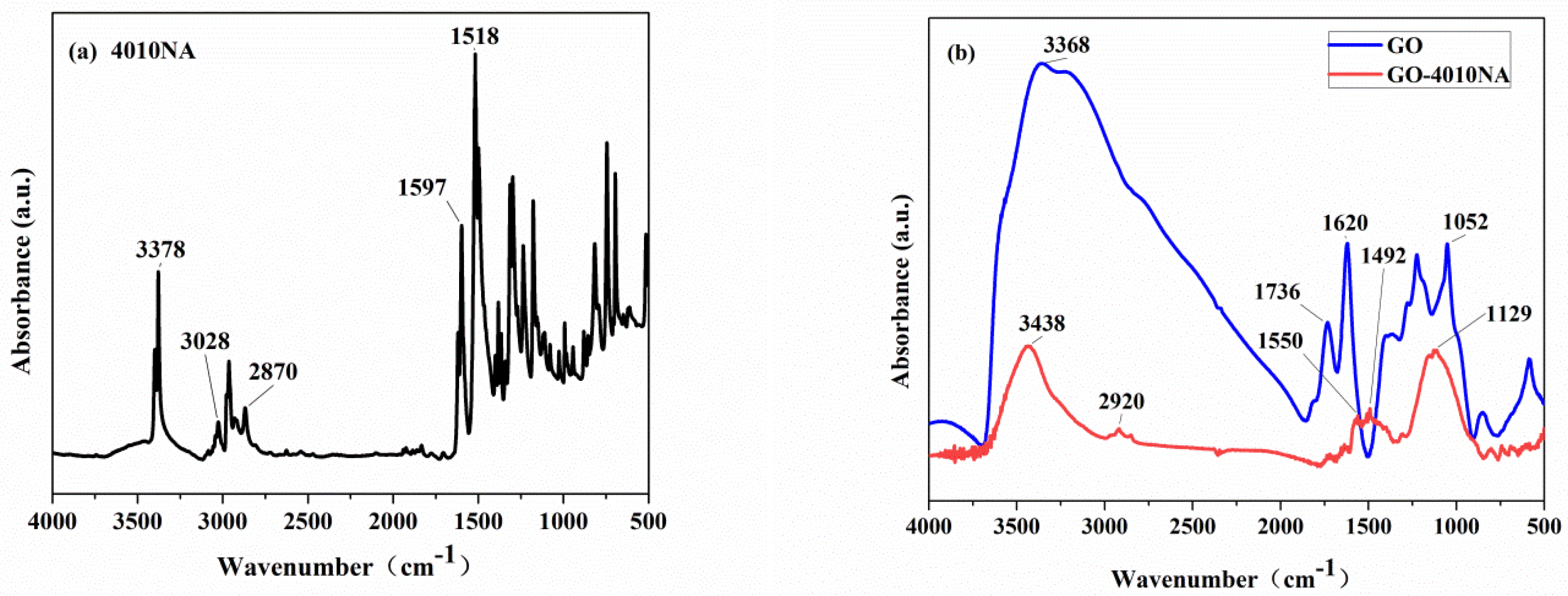

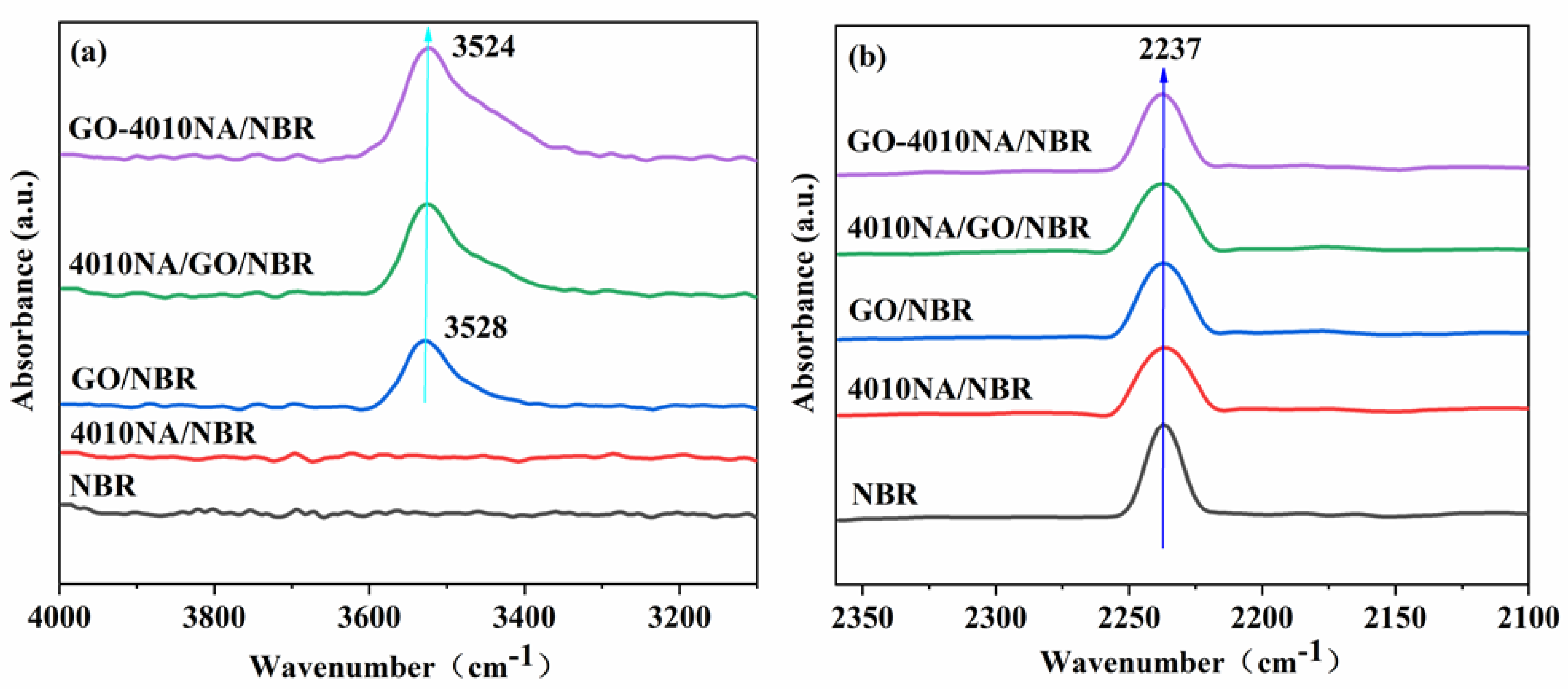

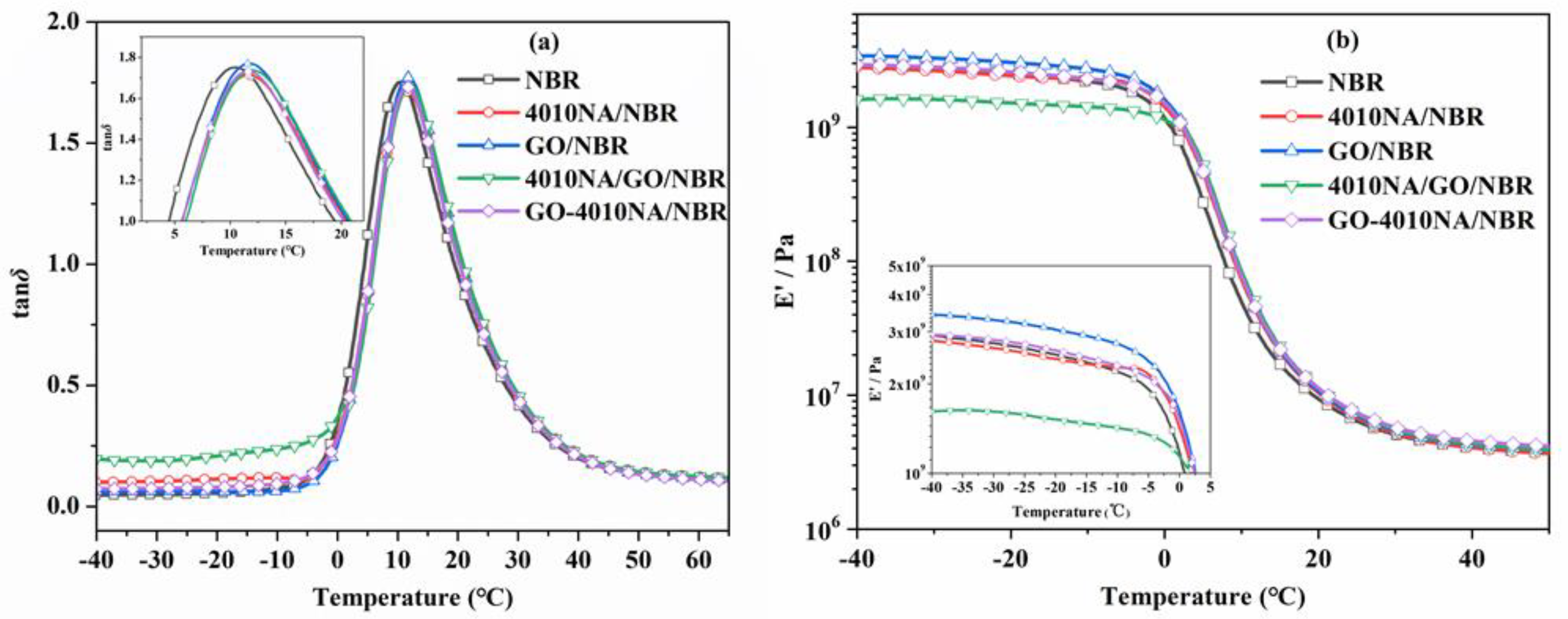

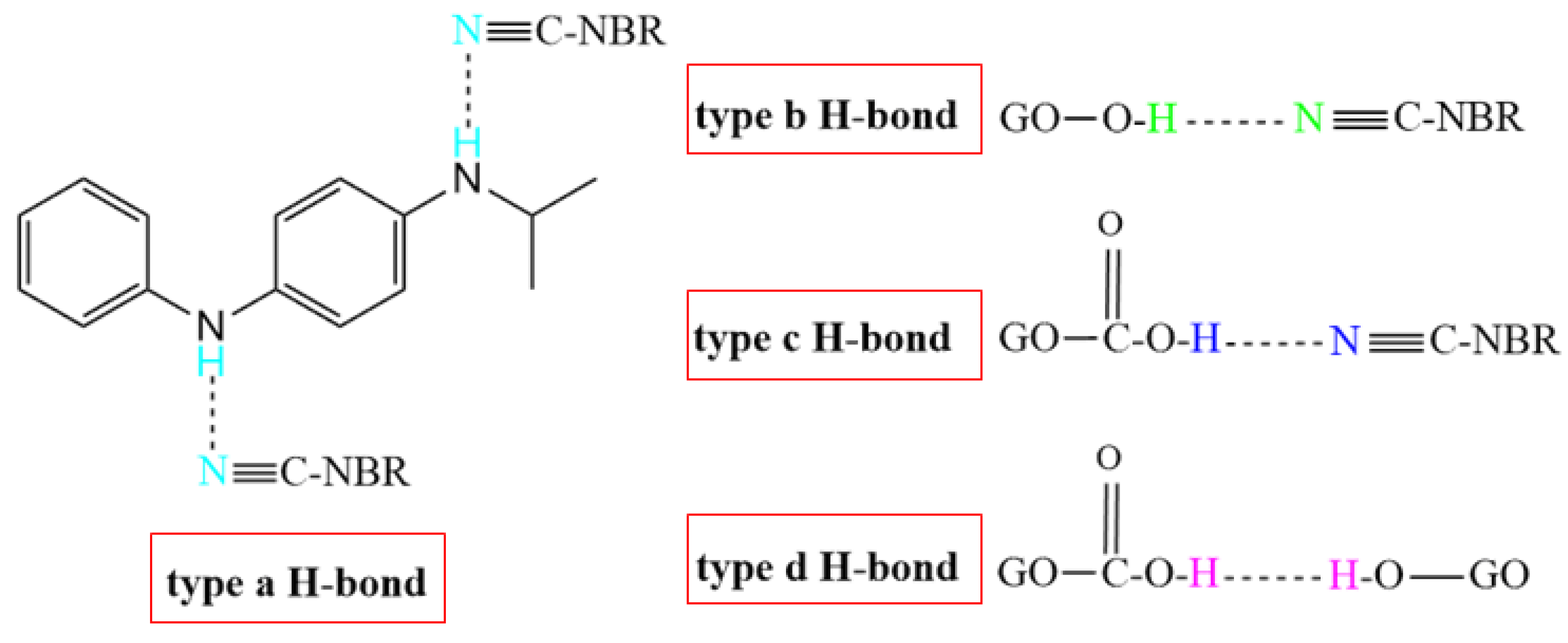

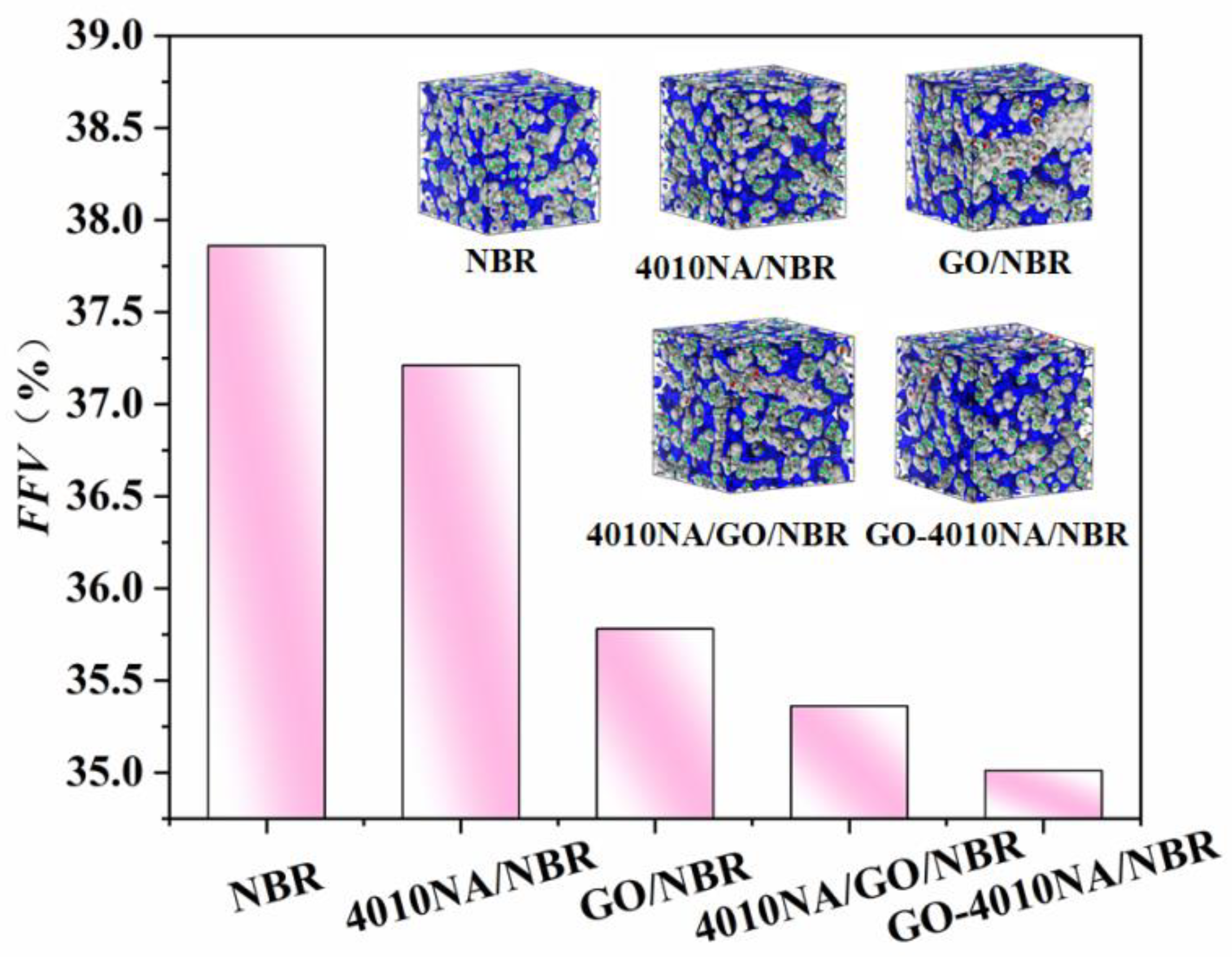

| Sample | Ingredients (phr) | |||
|---|---|---|---|---|
| NBR | GO | 4010NA | GO-4010NA | |
| NBR | 100 | |||
| GO/NBR | 100 | 1 | ||
| 4010NA/NBR | 100 | 0.1 | ||
| 4010NA/GO/NBR | 100 | 1 | 0.1 | |
| GO-4010NA/NBR | 100 | 1 | ||
| Sample | Tan δ Peak Position(°C) | Tan δmax | Temperature Range > 0.3 (°C) | TA | ||
|---|---|---|---|---|---|---|
| T1 | T2 | ΔT | ||||
| NBR | 10.39 | 1.75 | −0.56 | 34.04 | 34.60 | 31.12 |
| 4010NA/NBR | 11.78 | 1.71 | 0.13 | 35.17 | 35.04 | 29.58 |
| GO/NBR | 11.73 | 1.77 | 0.55 | 34.98 | 34.43 | 31.30 |
| 4010NA/GO/NBR | 11.95 | 1.74 | −2.18 | 35.23 | 37.41 | 27.50 |
| GO-4010NA/NBR | 11.75 | 1.73 | 0.34 | 34.68 | 34.34 | 30.05 |
| Materials | δvdW (cal/cm3)0.5 | Standard Error (cal/cm3)0.5 | δele (cal/cm3)0.5 | Standard Eror (cal/cm3)0.5 |
|---|---|---|---|---|
| NBR | 8.36 | 0.006 | 3.84 | 0.005 |
| 4010NA | 8.80 | 0.026 | 4.01 | 0.029 |
| GO | 10.32 | 0.009 | 5.98 | 0.016 |
| GO-4010NA | 7.53 | 0.009 | 4.38 | 0.012 |
| Polar Functional Groups | Atom | q(e) | Forced Field Type |
|---|---|---|---|
| -CN (NBR) | C | 0.234 | c2t |
| N | −0.428 | n1t | |
| -NH (4010NA) | N | −0.373 | n3h1 |
| H | 0.353 | h1n | |
| -OH (GO) | H | 0.410 | h1o |
| O | −0.570 | o2h | |
| -C-O-C (GO) | C | 0.160 | c44o |
| O | −0.320 | o2e | |
| -CO1O2H (GO) | H | 0.410 | h1o |
| O2 | −0.455 | o2c | |
| O1 | −0.450 | o1= | |
| C | 0.495 | c3′ |
| Sample | 4010NA/NBR | GO/NBR | 4010NA/GO/NBR | GO-4010NA/NBR |
|---|---|---|---|---|
| No. of type a H-bond | 3 | 0 | 1 | 2 |
| No. of type b H-bond | 0 | 11 | 12 | 8 |
| No. of type c H-bond | 0 | 5 | 5 | 4 |
| No. of type d H-bond | 0 | 11 | 12 | 11 |
| No. of total H-bonds | 3 | 27 | 30 | 25 |
Publisher’s Note: MDPI stays neutral with regard to jurisdictional claims in published maps and institutional affiliations. |
© 2022 by the authors. Licensee MDPI, Basel, Switzerland. This article is an open access article distributed under the terms and conditions of the Creative Commons Attribution (CC BY) license (https://creativecommons.org/licenses/by/4.0/).
Share and Cite
Song, M.; Yue, X.; Chang, C.; Cao, F.; Yu, G.; Wang, X. Investigation of the Compatibility and Damping Performance of Graphene Oxide Grafted Antioxidant/Nitrile-Butadiene Rubber Composite: Insights from Experiment and Molecular Simulation. Polymers 2022, 14, 736. https://doi.org/10.3390/polym14040736
Song M, Yue X, Chang C, Cao F, Yu G, Wang X. Investigation of the Compatibility and Damping Performance of Graphene Oxide Grafted Antioxidant/Nitrile-Butadiene Rubber Composite: Insights from Experiment and Molecular Simulation. Polymers. 2022; 14(4):736. https://doi.org/10.3390/polym14040736
Chicago/Turabian StyleSong, Meng, Xiulin Yue, Chaokang Chang, Fengyi Cao, Guomin Yu, and Xiujuan Wang. 2022. "Investigation of the Compatibility and Damping Performance of Graphene Oxide Grafted Antioxidant/Nitrile-Butadiene Rubber Composite: Insights from Experiment and Molecular Simulation" Polymers 14, no. 4: 736. https://doi.org/10.3390/polym14040736
APA StyleSong, M., Yue, X., Chang, C., Cao, F., Yu, G., & Wang, X. (2022). Investigation of the Compatibility and Damping Performance of Graphene Oxide Grafted Antioxidant/Nitrile-Butadiene Rubber Composite: Insights from Experiment and Molecular Simulation. Polymers, 14(4), 736. https://doi.org/10.3390/polym14040736







